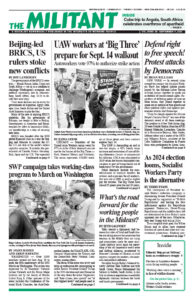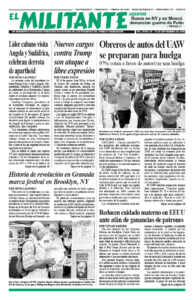The governments of the BRICS countries — Brazil, Russia, India, China and South Africa — set up as a coalition to challenge Washington’s economic and political supremacy, met in Johannesburg, South Africa, Aug. 22-24 to decide their next steps.
Their main decision was to invite the governments of Argentina, Egypt, Ethiopia, Iran, Saudi Arabia and the United Arab Emirates to join the bloc.
Many of the new or aspiring BRICS members, like the government of Ethiopia, are deeply in debt to Beijing. Governments in Argentina and Egypt, weighed by debts to imperialist banks, see membership as a way of securing new loans.
BRICS was founded after the 2008 global financial crisis as a way for Beijing and Moscow to counter the G7, the U.S.-led club of the world’s richest capitalist countries. It includes the governments of Canada, France, Germany, Italy, Japan and the U.K. The expanded BRICS bloc will now cover close to half the world’s population and over a third of its economic output.
The main movers of the BRICS alliance are the capitalist rulers in Beijing, who are seeking ways to chip away at U.S. imperialism’s dominance.
Chinese President Xi Jinping cited “common interests of emerging markets and developing countries” in pushing for the group’s expansion. But the alliance is riven by competing national interests of its various ruling classes. The governments of Brazil, India and South Africa oppose lining up behind Beijing against Washington.
The Indian government, moreover, faces clashes with the Chinese rulers over control of a disputed border region, as well as rivalry with Beijing for markets, resources and influence across Asia. This has spurred Indian Prime Minister Narendra Modi to seek closer ties with the imperialist powers in the U.S., Japan and Australia.
No replacement for U.S. supremacy
The governments of India and South Africa opposed a proposal by Brasilia before the summit to move toward a BRICS-backed currency. Outside the eurozone, 79% of world trade is conducted in dollars. The dollar is backed by the military and economic clout of Washington. No agreement was reached.
The BRICS leaders settled for member states carrying out more trade in local currencies. Dollar-strapped governments, like in Argentina, are already using the Chinese yuan in certain transactions.
To try to counter the U.S.-led International Monetary Fund and World Bank, BRICS governments set up their own New Development Bank in 2015.
But the reality of Washington’s domination of world financial transactions has become even clearer since Moscow’s invasion of Ukraine. Washington’s sanctions on Russia have forced the New Development Bank to suspend all operations in Russia. Wall Street lenders have stopped advancing loans to the NDB. Two-thirds of borrowing by the bank — set up to counter the greenback — is actually dollar-denominated!
The Chinese rulers’ relative weakness has become even more obvious recently. They face a property market meltdown, falling exports and mounting local government debt. Youth unemployment stands at 20%. These conditions are likely to accelerate not only Beijing’s, but the global, economic crisis.
Since Moscow’s invasion, the New Development Bank has had to double the premium it charges to borrowers. It’s issuing far fewer loans than before the war in Ukraine.
Russian President Vladimir Putin faced arrest if he traveled to the summit. That’s because the International Criminal Court — of which host South Africa is a member — issued an arrest warrant for him related to his invasion of Ukraine. He joined the gathering by video link. He made demagogic appeals to attendees to help create “a new multipolar world order.”
Xi and Putin claim to present an alternative to neo-colonialism. They tap into a real aversion by semicolonial governments to Washington and other imperialist powers over their long history of bloody colonial oppression and exploitation. Moscow and Beijing make these claims despite the fact the Russian rulers are at war to subjugate the Ukrainian people.
Beijing has spent $1 trillion on giant Belt and Road infrastructure projects aimed at expanding its control over trade routes and grabbing markets. Many governments in Asia, Africa and Latin America have sunk deeper into debt to China’s banks to pay for these projects. If governments default, Beijing can seize facilities as it did with the Sri Lankan port of Hambantota.
For Beijing these projects are a door to military expansion, deepening the conflict with Washington beyond Asia. The Chinese rulers opened their first military base abroad in Djibouti in 2017.
The course pushed by Beijing in its escalating rivalry with Washington, is the opposite of that advanced by Cuban communist leader Fidel Castro when he led the Non-Aligned Movement. This organization was established as a product of the giant struggles that uprooted colonial domination in the 1950s. In 1979 Castro chaired the movement, speaking out against imperialist plunder and led calls for cancellation of the debt owed by oppressed nations.
Days before the BRICS summit, President Joseph Biden hosted a meeting with government heads of Japan and South Korea at Camp David Aug. 18. Biden used the meeting to bolster Washington’s alliances as a counterweight to Beijing’s military expansion in the Pacific.
Japan occupied Korea from 1910 to 1945, looting the country. During World War II Japanese rule over the Korean people included forced labor and using Korean women as sex slaves.
Despite this history, Biden secured the agreement of Washington’s two closest allies in East Asia to deepen military and economic cooperation.

